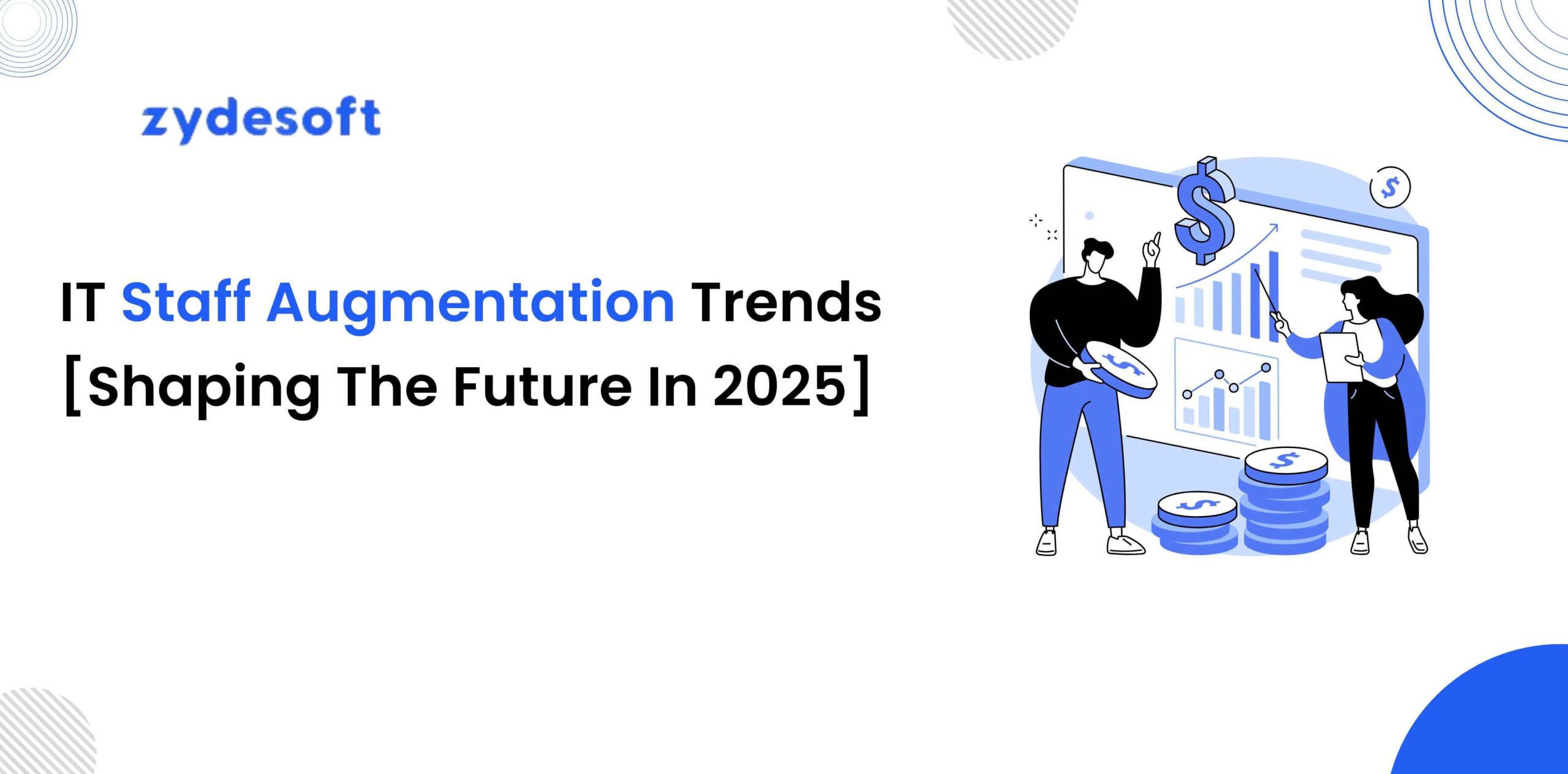
Finding the right IT talent fast is a challenge many businesses face today. With technology evolving at lightning speed, companies can’t afford to spend months on traditional hiring. That’s where IT staff augmentation trends come in—a flexible, cost-effective model that helps businesses quickly scale their workforce with skilled professionals.
According to PR Newswire, the global staff augmentation market is set to grow by $81.87 billion, with a CAGR of 3.53% over the next five years. This surge is fueled by the increasing demand for specialized tech talent, cost-efficiency, and the need for faster project delivery.
In 2025, IT staff augmentation will continue to redefine the hiring landscape. Companies are adopting this model to bridge skill gaps, meet project deadlines, and stay competitive in a tight labor market.
But how can businesses successfully implement staff augmentation? What challenges should they watch out for? This blog will explore the top IT staff augmentation trends in 2025, key benefits, common pitfalls, and expert strategies to make this model work for you.
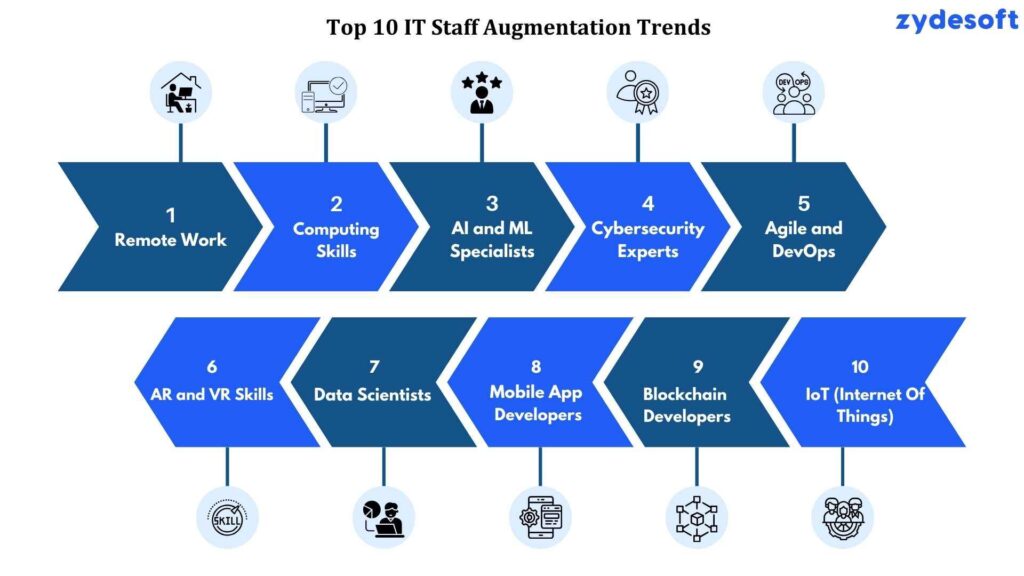
IT staff augmentation is transforming how businesses hire skilled professionals, ensuring flexibility, cost-efficiency, and access to top-tier tech talent. Below is a structured table highlighting the biggest IT staffing trends of 2025, including focus areas, key roles in demand, and industries benefiting from them.
| Trend | Focus Area | Key Roles in Demand | Industries Leveraging the Trend |
| Remote Work | Leveraging global talent through remote hiring to enhance flexibility and reduce costs. | Remote developers, Project managers, and Team leaders | IT, E-commerce, SaaS, FinTech |
| Cloud Computing Skills | Growing demand for cloud specialists to manage secure, scalable infrastructures. | Cloud architects, Cloud engineers, Cloud security specialists | Healthcare, Retail, Banking |
| AI and Machine Learning Specialists | Companies are investing in AI and ML for automation, predictive analytics, and personalization. | Machine learning engineers, Data scientists, NLP engineers | Finance, Healthcare, Marketing |
| Cybersecurity Experts | Rising cyber threats require strong security measures and compliance specialists. | Ethical hackers, Cybersecurity analysts, Compliance officers | Banking, Government, E-commerce |
| Agile and DevOps | Businesses are accelerating software development through Agile and DevOps practices. | Scrum masters, DevOps engineers, Agile coaches | Software Development, IT, Telecom |
| AR and VR Skills | AR/VR technology is creating immersive experiences in gaming, retail, and healthcare. | AR/VR developers, 3D modelers, Hardware integrators | Gaming, Healthcare, Retail |
| Data Scientists and Analysts | Extracting actionable insights from big data to drive business decisions. | Data scientists, Data analysts, Database managers | Marketing, Supply Chain, Finance |
| Mobile App Developers | Companies are prioritizing mobile-first strategies with innovative apps. | iOS developers, Android developers, Cross-platform developers | E-commerce, Entertainment, Education |
| Blockchain Developers | Expanding blockchain applications beyond cryptocurrency into decentralized solutions. | Blockchain developers, Smart contract specialists, DApp developers | Finance, Supply Chain, Real Estate |
| Demand for IoT Expertise | IoT adoption is revolutionizing industries by connecting devices for automation. | IoT developers, Embedded systems engineers, IoT security specialists | Manufacturing, Smart Homes, Healthcare |
Remote work is no longer a temporary fix—it’s a long-term business strategy. Companies worldwide are embracing IT staff augmentation to hire top-tier developers, engineers, and IT experts—without geographic restrictions.
According to Chegg’s 2024 IT Workforce Trends Report, 70% of IT professionals now work remotely. This shift is transforming how companies recruit, manage, and retain top tech talent.
Global Talent Pool
Cost Savings
Flexibility & Productivity
To fully utilize remote IT staff augmentation, companies should:
Cloud computing has become the backbone of modern IT infrastructure, enabling businesses to scale operations, enhance security, and optimize costs. By 2025, the global cloud computing market is expected to be valued at $832.1 billion, according to PRNewswire’s Cloud Market Report.
Companies are quickly moving to cloud-based systems, increasing demand for highly skilled cloud professionals in key areas.
Key Roles Shaping Cloud Computing in 2025
Cloud Architecture & System Design
Cloud Migration & Deployment
Cloud Security & Cost Optimization
AI and machine learning are reshaping businesses, making highly skilled AI professionals more essential than ever. The demand for data-driven insights, automation, and personalization is rapidly increasing, influencing IT staff augmentation trends in 2025.
According to a GlobeNewswire report, the AI industry is projected to grow at a CAGR of 42.2% between 2020 and 2027, increasing the need for AI experts across industries.
Predicting Market Trends
Automating Repetitive Tasks
Delivering Personalized Experiences
Cyberattacks are becoming more frequent and complex, making cybersecurity a top priority for businesses worldwide. As cyber threats evolve, companies must strengthen their security infrastructure to protect data, comply with regulations, and prevent financial losses.
According to GlobeNewswire’s 2030 Cybersecurity Market Report, the global cybersecurity market is projected to reach USD 424.97 billion, underscoring the urgent need for skilled cybersecurity professionals.
With rising threats, IT staff augmentation trends show a growing reliance on contract-based cybersecurity experts to provide immediate, specialized protection without long-term hiring constraints.
Detection & Response
Ethical Hacking & System Testing
Regulatory Compliance & Risk Management
The shift toward Agile and DevOps methodologies is redefining software development, enabling businesses to achieve faster releases, improved collaboration, and higher-quality software. With digital transformation accelerating, companies that fail to embrace these practices risk falling behind.
According to Gartner, over 85% of IT companies will have fully integrated DevOps by 2025, revolutionizing the way teams collaborate, test, and deploy applications.
DevOps connects developers, operations, and QA, leading to:
The use of AR and VR is transforming IT staff augmentation trends, expanding beyond gaming into industries like retail, healthcare, and education. Companies looking to hire specialized AR/VR developers will see increasing demand in 2025.
The global AR/VR industry is projected to reach $114.5 billion by 2027, signaling a major hiring shift in IT staffing.
As AR and VR continue to grow, businesses looking to stay ahead in 2025 IT staffing trends should focus on:
Companies that invest in AR/VR talent will gain a competitive edge, offering immersive experiences that set them apart in 2025. IT staff augmentation providers can bridge the skill gap by connecting businesses with specialized AR/VR developers.
In 2025, data science is one of the biggest drivers of IT staff augmentation trends. Businesses across finance, healthcare, e-commerce, and technology are actively hiring data professionals to extract valuable insights from massive datasets. The increasing need for real-time data analysis is fueling demand for skilled data scientists, analysts, and business intelligence professionals.
The global data science industry is projected to reach $378.7 billion by 2030, growing at a 27.8% CAGR. This rapid expansion is shaping IT staffing trends, with companies hiring pre-vetted data experts to gain a competitive edge.
Data Mining for Business Growth – Data scientists extract meaningful patterns from raw data using advanced tools and techniques. Companies rely on skilled data professionals to uncover trends that optimize marketing strategies, detect fraud, and improve operational efficiency.
Predictive Modeling for Smarter Decision-Making
Hiring data analysts is crucial for businesses that want to forecast sales trends, assess risks, and make informed decisions. With machine learning models, companies can predict customer behavior, identify growth opportunities, and mitigate financial risks.
Data Visualization & Reporting
Decision-makers don’t just need raw numbers—they need easy-to-read dashboards and reports to make sense of complex data. Skilled data visualization experts create interactive dashboards that help businesses adopt a data-driven culture.
With data becoming the foundation of modern business strategy, companies that leverage IT staffing trends to hire skilled data professionals will gain a significant competitive advantage in 2025.
In today’s digital landscape, mobile applications are essential for businesses to engage with customers and drive revenue. As mobile usage surges, companies are increasingly relying on IT staff augmentation trends to hire skilled mobile app developers.
The global mobile app industry is projected to reach $366.3 billion by 2030, growing at a CAGR of 14.4% (Source: Verified Market Research). This rapid expansion is reshaping IT staffing trends, with companies hiring on-demand mobile developers to keep up with consumer expectations.
With mobile applications driving digital transformation, businesses that leverage IT staff augmentation trends to hire skilled mobile developers will stay ahead of the competition in 2025. Whether it’s native, cross-platform, or UI/UX expertise, on-demand hiring solutions help companies build high-quality apps without delays or budget constraints.
Blockchain is changing industries beyond digital currencies, helping businesses improve supply chain tracking, healthcare security, and real estate transactions. Many companies are using IT staff augmentation trends to find blockchain experts who can build secure and transparent systems.
The blockchain market is projected to reach $39.7 billion by 2025 (Source: PRNewswire).
The Internet of Things (IoT) is revolutionizing industries by enhancing automation and real-time data access. Companies are embracing IT staffing trends to hire IoT experts who connect devices securely and optimize operations. The IoT market is expected to hit $1.1 trillion by 2026.
Why Businesses Need IoT Developers
By exploring IT staff augmentation trends, businesses can quickly hire top blockchain and IoT developers, staying ahead in 2025’s digital landscape.
This process of IT staff augmentation supports businesses in growing their workforce effectively through the utilization of outside talent for jobs. It also has versatility, and massive cost savings, and provides the benefit of seeing talent from around the world. Here is an elaborative view of the steps that are involved in IT staff augmentation:
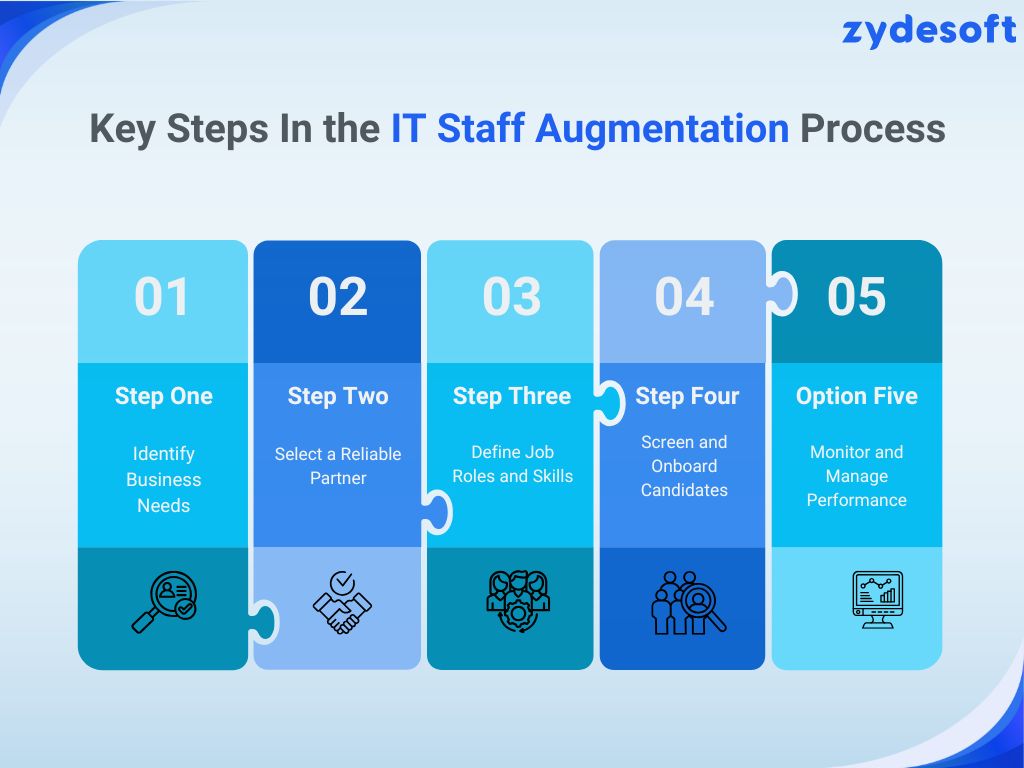
Knowing what your business needs is the first step to successful IT staff help. This means looking at your current team’s skills, figuring out what the project needs, and finding gaps that need to be filled.
Example: If your company is launching a mobile app, you might need to hire mobile app developers proficient in Flutter or Swift to complement your in-house team.
One should be able to easily and immediately find the right people through a good IT staff augmentation provider. Staying updated on IT staff augmentation trends can help identify valued partners who ensure easy and smooth integration with skilled workers that meet your project’s requirements.
Key Consideration: Choose a partner who understands your industry and can provide talent with relevant experience.
Define your roles and skills required well in advance before actually engaging with a staff augmentation partner. A proper job description helps filter good candidates who will, in turn, match up to your expectations.
Example: If hiring for a cybersecurity role, specify requirements such as experience in ethical hacking, threat analysis, and regulatory compliance knowledge (e.g., GDPR).
Once the partner provides a shortlist of candidates, it’s time to screen and onboard them effectively. Proper evaluation ensures that the selected professionals align with your technical and cultural expectations.
Tip: Streamline onboarding with clear documentation and training resources to help the new hires hit the ground running.
Effective monitoring ensures that augmented staff delivers quality work and remains aligned with your project’s objectives. Regular feedback and performance evaluations can enhance productivity and foster better collaboration.
Pro Tip: Treat augmented staff as an extension of your team to build trust and promote teamwork.
While IT staff augmentation offers flexibility, cost-effectiveness, and access to global talent, it also comes with unique challenges. Businesses need to address these issues to maximize the benefits of augmented staff and ensure seamless project execution. Below are some of the most common challenges associated with IT staff augmentation and ways to overcome them:
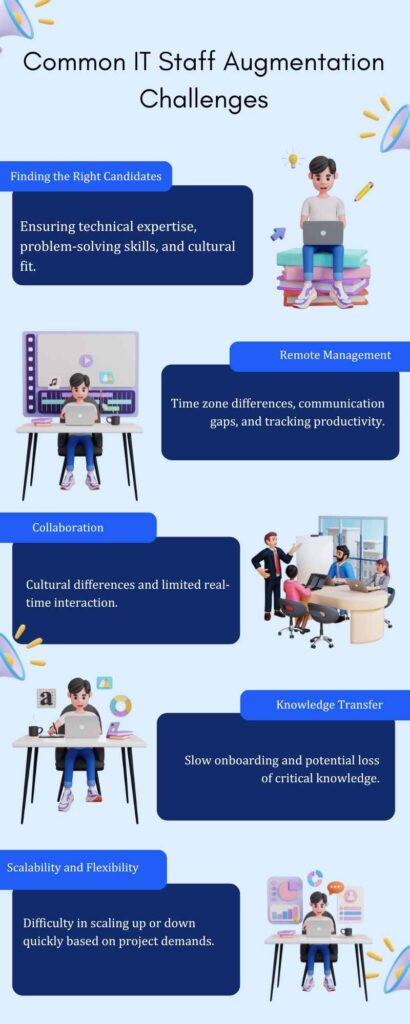
Finding the right talent can be a daunting task, especially when there’s a large pool of applicants. Ensuring that the chosen candidates align with your project requirements and company culture is critical.
Managing remote or distributed teams can be challenging due to differences in time zones, communication gaps, and lack of visibility into progress.
Effective teamwork can be difficult when augmented staff are not physically present with the in-house team. Misunderstandings or a lack of rapport can hinder project progress.
Ensuring smooth knowledge transfer between in-house teams and augmented staff is crucial for long-term project success. A lack of documentation or training can slow down the onboarding process and impact efficiency, especially as IT staffing trends highlight the growing reliance on external expertise to meet project demands.
As projects evolve, the need for flexibility in scaling teams up or down becomes crucial. Rigid staffing structures can limit the ability to meet changing demands or deadlines. Ensuring that your IT staff augmentation process is scalable allows you to adjust quickly to new requirements or project phases.
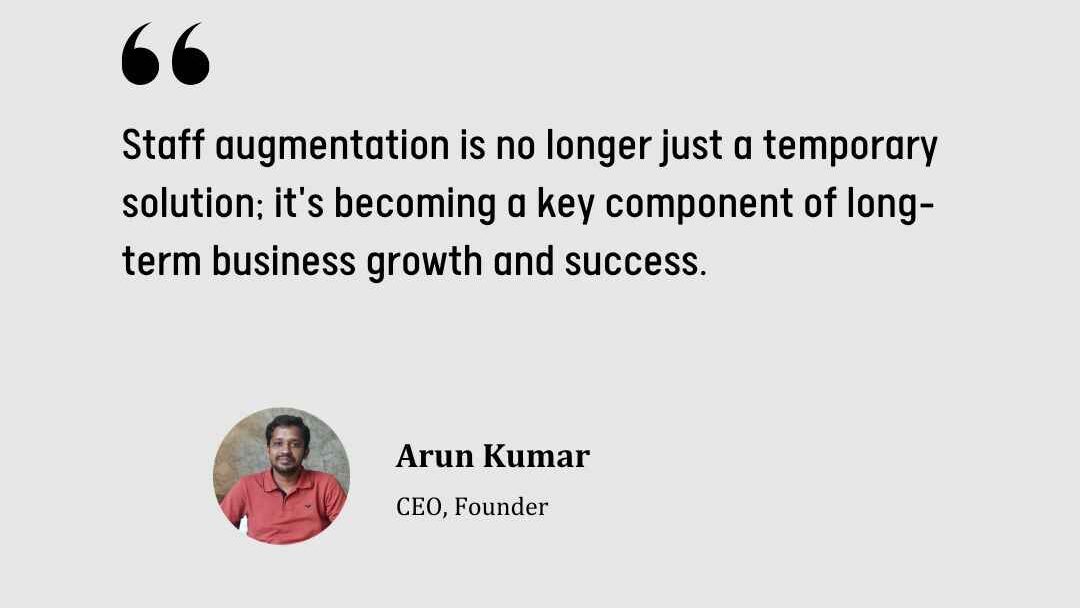
To mitigate these challenges effectively, businesses should adopt a proactive and strategic approach:
IT staff augmentation is a game-changer for businesses seeking flexibility, scalability, and access to global talent. By understanding the top IT staff augmentation trends in 2025, companies can better prepare to leverage this model effectively.
From addressing skills shortages to driving innovation, IT staff augmentation is an essential strategy in today’s competitive landscape. Stay ahead by partnering with reliable augmentation providers and focusing on seamless integration and collaboration.
FAQs
1. How can I hire the top IT staff augmentation company?
To hire a top IT staff augmentation company, research their portfolio, client reviews, and case studies. Ensure they offer vetted talent, flexible engagement models, and cost-effective solutions tailored to your needs.
2. What are the current IT staff augmentation trends in 2025?
In 2025, IT staff augmentation is characterized by the integration of AI-driven talent matching, a surge in demand for niche expertise, and the normalization of remote work models, enabling businesses to swiftly adapt to technological advancements and market dynamics.
3. How can staff augmentation solutions benefit my business?
Staff augmentation provides flexible access to skilled professionals, allowing you to scale your team quickly while saving on hiring and operational costs. It’s a cost-effective way to fill talent gaps and accelerate project timelines.
4. What types of IT augmentation services does Zydesoft offer?
Zydesoft offers a wide range of IT augmentation services, including React JS, AI, javascript, android, iOS, angular, Java, DevOps and more.